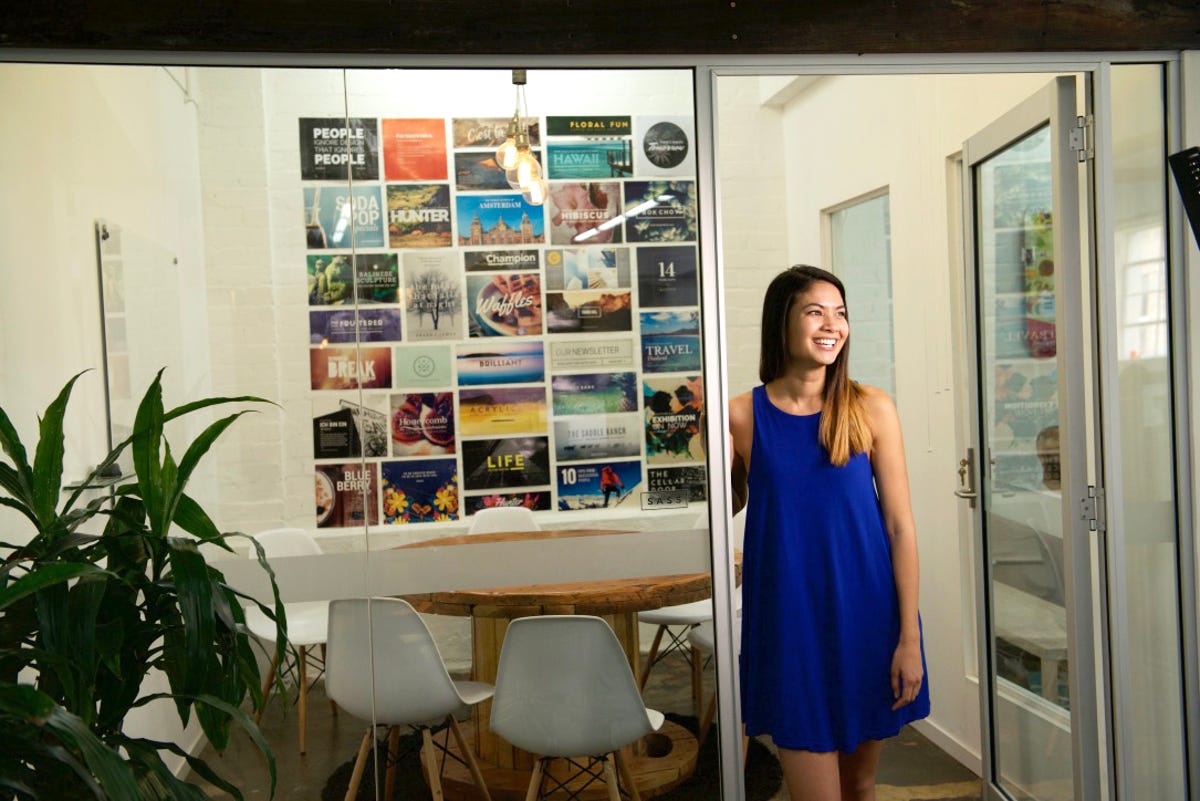Canva poster design online canva create a poster poster making using canva canva for creating posters how to create poster in canva how to make a poster using canva how to make a poster landscape in canva canva poster design canva themeforest canva themplate cuban

Canva: The poster child of DIY graphic design
Good design is hard. But more and more we all have to do it. Whether it's a nice Facebook banner, a clever profile pic, an eye-catching Instagram post or some well polished ideas for a work presentation, we all want something more than the terrible basic options offered up by Powerpoint.
Enter Canva. The 5-year-old Australian startup is all about offering slick templates through a free service that is exceptionally simple to use. Whether through its website or the apps for iPhone and iPad, it takes just a few seconds to work out how to get started and make something that looks great.
This all sounds like an ad -- simple DIY design sounds too good to be true -- but a quick taste test proves how true the pitch is. And after a slow boil for its first few years, a rapid climb to over 10 million users across 179 countries (Canva says it just passed five designs per second) suggest this is something that is starting to resonate.

Co-founder Melanie Perkins wants to give everyone the tools to make good everyday designs with minimal fuss.
Canva"Having great quality ingredients for people to work with has been a driving premise behind Canva," says Melanie Perkins, co-founder of Canva. "Before Canva, you'd have to be a professional designer to easily access beautiful stock photography and illustrations. There are template libraries out there, but again, they're only for designers who use professional design software."
While the service is free, Canva makes money through the sale of stock images as well as a "Canva for Work" premium offering that lets a company set brand guidelines and templates to make it easier for people all around a company stick to core design principles without always needing designers to create every document, every presentation or whatever else may be required.
"Social media posts, pitch decks, proposals, marketing materials. Designers are getting spread really thin throughout organisations," says Perkins. "They often have to neglect sales, for example, who often just string their own terribly off brand things together. This really helps to bring brand identity together. Colours, fonts, logos so everybody is on the right track."
Democratising design
Exploring the Canva website, beyond the design tools the company also offers anyone who wants it a crash course in good design. There's a design school blog, design tutorials and a design stream where you can see what other people have been designing and offer likes and comments. Perkins suggests people have been conditioned to think they're just not creative, so they're often afraid to play around.
Canva's usage has been on a rapid rise, now surpassing five designs per second across its web and app platforms.
CanvaWhen Canva first launched, the company's user research found people were inherently afraid to click things in case they messed something up.
"People were really conscious about not clicking too much and not playing around. But this is meant to be the exact opposite," says Perkins. "So we introduced starter challenges -- put a hat on a monkey, change the colour of a circle, add a background to a page, really basic things. But each step builds confidence."
Offering templates that don't get too repetitive is a big challenge, but Canva has tried to solve for this concern by inviting professional designers to share templates publicly and receive royalties whenever their templates are used by others.
For Perkins, it's the success stories of those who have been using Canva that make her feel like they're achieving their mission. From the story of a small US sheriff's office using Canva to create wanted posters, to the story of a woman who created an image to help track down her birth mother that worked after going viral on Facebook.
Australia's coolest tech company
Canva is fast becoming the proverbial and literal poster child of the Australia startup scene. From humble origins in Perkins' mother's living room and "incubating" in San Francisco food courts, the company is now growing rapidly with a team of over 120 across 3 countries and a latest funding round of AU$19.8M at a valuation of AU$462M.

Canva across the web, iPhone and iPad. "Other platforms" (read Android) are planned for the future.
CanvaThe company also provides classic Silicon Valley perks, with an in-house chef, free gym and yoga classes, flexible working conditions and more. It was all enough to land Canva the title of Australia's Coolest Tech Company two years running from job listings website Job Advisor.
"We're in the ridiculously fortunate position that before we took on this latest funding we hadn't spent a dollar from the previous round," says Perkins. "We got the revenues to grow rapidly and everything sort of naturally moving in the right direction."
There's still a lot more to do. Getting apps on Android is an obvious one, but Perkins suggests the company is only scratching the surface of its larger, and far loftier, long term plans.
"If we can become the productivity tool, the productivity platform for the next generation, with all the crazy needs everyone has for visual content they need to create, that would be pretty cool."
Source
Blog Archive
-
▼
2022
(240)
-
▼
October
(83)
- Best E Ink Tablets For 2022: Note-Taking Solutions...
- Vizio M-Elevate Soundbar Review: Great Sound, Elev...
- Bridgerton Was The Biggest Thing On Netflix Last W...
- Apple Watch SE Sale: Save $60 Ahead Of Cyber Monday
- Rev Up For A Live-Action Hot Wheels Movie From J.J...
- Samsung Summer Sale: Up To $800 Off Appliances And...
- Paramount Plus, Showtime Now Available In A Single...
- Lenovo Staff Loses Company-issued Laptop... And Co...
- Who Is WhatsApp Co-founder And CEO Jan Koum?
- 2022 Honda Pilot Sport Becomes New Base Trim, Resu...
- Uber Will Rent Teslas To Its Drivers Through New H...
- Oppo Find X5 Pro: Five Reasons This Flagship Andro...
- Facebook Is Shutting Down Its Facial Recognition S...
- All The Google Docs Features From My Wish List Tha...
- Netflix Rejigging Squid Game To Cut Phone Number A...
- Best Mattresses For Kids In 2022
- Pixel 6 Pro Review: Google's Flagship Is Still A T...
- High-end Drip Coffee Makers That Take Brewing Seri...
- Canva: The Poster Child Of DIY Graphic Design
- Halloween PlayStation, Xbox And Switch Game Sale
- How To Stream Netflix's Epic Kanye West Doc Today,...
- Facebook's Global Head Of Safety Hasn't Fully Read...
- Hindsight Asks Players To Confront Loss, Grief And...
- Xiaomi Redmi Note 5 Is An Android Phone For The Ma...
- 'All The Old Knives' Review: Lacklustre Chris Pine...
- Google Updates In-App Billing Rules To Allow Rival...
- Best Wi-Fi 6 Routers Of 2022
- Pac-Man Live-Action Film In Development
- The Trick To Getting A Gym Membership For Practica...
- Microsoft Store On Windows To Allow Third-party St...
- 'Nope' Isn't Streaming Yet, Sorry (but Here's When...
- Ring Alarm Pro Review: A Giant Leap For Home Security
- Remember Chumby? Cute Touchscreen Gadget Returns F...
- Streaming Means You'll Never Own Your Favorite Mov...
- Best Drones For 2022
- IPadOS: 5 Best New Security And Privacy Features F...
- Acer Reveals Chromebooks, Eco-friendly Laptops, Ga...
- 2023 Kia Sportage Hybrid Review: Grow Up, Glow Up
- Forget The Galaxy S22 And Get An S21: Main Differe...
- 9 Great Reads From CNET This Week: PS5, Apple Watc...
- The Trick To Finding Free Wi-Fi Anywhere In The World
- How To Turn An IPad Into A Second Display For Your...
- Halloween 2019: Last-minute Costumes You Can Get O...
- Robinhood Starts Rolling Out Beta Version Of Crypt...
- WhatsApp Is The World's Most Popular Messaging App...
- 2022 Kia Carnival First Drive Review: A Luxurious ...
- NASA And SpaceX Prep Halloween Launch For Crew-3 T...
- $55,000 Honda Civic Si FE1 Is An Accessible Turnke...
- Forest Bathing: The Free Cure For Stress And Anxiety?
- How To Get Your New Backyard Ready For Hosting
- Get The Motorola One 5G Ace For $30 When You Sign ...
- Best USB-C Monitor Deals: Get A 24-Inch FHD Displa...
- Ransomware Cost US Schools $3.56 Billion In 2021, ...
- DJI Osmo Mobile 2 Will Be The Phone Camera Stabili...
- AMD Previews CPUs For Cheap Laptops, Flagship Gami...
- Instant Pot's Vortex Plus Proves 2019 Really Is Th...
- Don't Have AC? Try Putting Your Socks In The Freezer
- 2022 Bentley Flying Spur Hybrid Review: Your Milea...
- Xiaomi Mi Mix 3: Release Date, Price, Specs, Four ...
- Hailee Steinfeld Finally Confirms She's In The New...
- $10,000 Or $50,000 Student Loan Forgiveness: Could...
- New Gadget Warns You When You Smell Bad
- What It's Really Like At 'Hacker Summer Camp'
- When Local Newspapers Fold, Polarization Rises. He...
- Xiaomi Redmi 3 Review: Xiaomi's Redmi 3 Is Pretty ...
- Unplug These Appliances To Save $100 Each Year
- Apple's IOS 15.2 Update: How To Download, New Feat...
- World's Oldest Living Dog Is A Toy Fox Terrier Tha...
- SpaceX's Starlink Satellite Broadband Is Coming To...
- LG's Star Wars C2 OLED TV Goes On Sale
- How To Fix Netflix Error Code M7111-5059 If You Ha...
- The Best Sci-Fi Movies On Netflix You Absolutely N...
- A Gadget To Test For Food Allergies? Not A Piece O...
- Pokemon Sword And Shield Players Can Get A Shiny G...
- San Diego Comic-Con 2022 Highlights: New Avengers ...
- How To Adjust To The End Of Daylight Saving Time
- 'House Of The Dragon' Small Council: What Do Those...
- Deleting Your Twitter? Here's How To Archive Your ...
- Windows 11 Review: Microsoft's Subtle Changes Make...
- 2022 Honda Civic Sedan, Hatchback Designs Show Up ...
- WWE WrestleMania 38 Sunday Results: Reigns Wins, F...
- I Bonds Fight Inflation With A 9.62% Return: How L...
- Rhythm Action Game Thumper: Pocket Edition Now Ava...
-
▼
October
(83)
Total Pageviews
Search This Blog
Popular Posts
-
Cartao de credito de tester, gerador de cartao de credito de portugal, santander cartao de credito desbloquear, cartao de credito de alumini...
-
Ukuran name tag yoyo stroller, ukuran name tag yo yo tricks, ukuran name tag yoyo games, ukuran name tag yoyo loach, ukuran name tag yoyo bu...
-
Ukuran f4 sama dengan a4 paper, ukuran f4 sama dengan a4 size, ukuran f4 sama dengan a4a, ukuran f4 sama dengan a4 apparel, ukuran f4 sama d...
